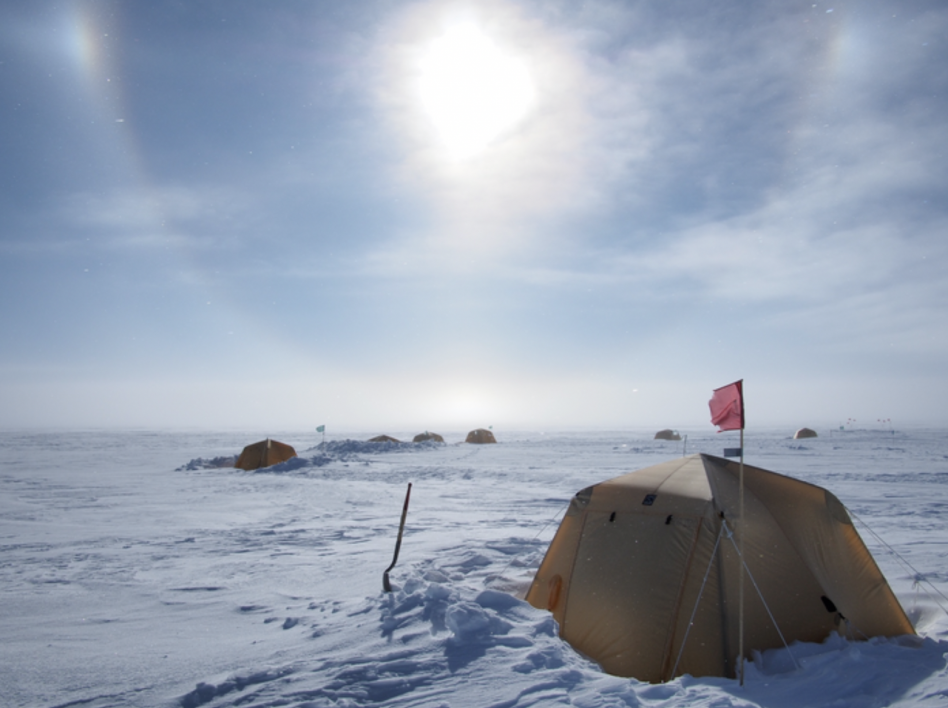Study shows most detailed glimpse yet of Earth's seasonal data from past 11,000 years

An international team of scientists has completed the most detailed look yet at the planet’s recent climatic history, including seasonal temperatures dating back 11,000 years to the beginning of what is known as the Holocene period.
The study, published recently in Nature, is the very first seasonal temperature record of its kind, from anywhere in the world.
“The goal of the research team was to push the boundaries of what is possible with past climate interpretations, and for us that meant trying to understand climate at the shortest timescales, in this case seasonally, from summer to winter, year-by-year, for many thousands of years,” said Tyler Jones, lead author on the study, and assistant research professor and fellow at the Institute of Arctic and Alpine Research, or INSTAAR.
ASU researcher Joshua Garland
Jones teamed up with Joshua Garland, an associate research professor in the Global Security Initiative at Arizona State University, to utilize his expertise in information theory to reexamine ice cores from the West Antarctic ice sheet.
“Using information theory, we can target ice and re-sample it, using new technologies,” said Garland. “We're able to get a much clearer picture of what was happening in the past. Which is great. That means we maximized the value of the ice that we had.”
A look back in time
Scientists around the world have long studied Earth’s past climate using ice cores gathered from the poles. These slender, cylindrical columns of ice, drilled from ancient ice sheets (mostly in Antarctica and Greenland), provide valuable long-term data trapped in time about everything from past atmospheric concentrations of greenhouse gases to past temperatures of the air and oceans.
For the new study, the team’s precious samples came from the West Antarctic Ice Sheet Divide ice core, the longest ice core ever drilled by U.S. researchers. Overall, it measures 11,171 feet (or over 2 miles) long and 4.8-inches in diameter — containing data from as old as 68,000 years ago. Ice cores like West Antarctic Ice Sheet are then carefully cut into smaller sections, which can be safely transported to and stored or analyzed in ice core labs around the country.
The study results validate one aspect of a long-standing theory about Earth’s climate that has not been previously proven: how seasonal temperatures in polar regions respond to Milankovitch cycles. Serbian scientist Milutin Milankovitch hypothesized a century ago that the collective effects of changes in Earth's position relative to the sun — due to slow variations of its orbit and axis — are a strong driver of Earth's long-term climate, including the start and end of ice ages (prior to any significant human influence on the climate).
“I am particularly excited that our result confirms a fundamental prediction of the theory used to explain Earth’s ice-age climate cycles: that the intensity of sunlight controls summertime temperatures in the polar regions, and thus melt of ice, too,” said Kurt Cuffey, a co-author on the study and professor at the University of California Berkeley.
These more highly detailed data on long-term climate patterns of the past also provide an important baseline for other scientists, who study the impacts of human-caused greenhouse gas emissions on our present and future climate. By knowing which planetary cycles occur naturally and why, researchers can better identify the human influence on climate change and its impacts on global temperatures.
“This research is something that humans can really relate to because we partly experience the world through the changing seasons — documenting how summer and winter temperature varied through time translates to how we understand climate,” Jones said.
Getting to the core of the problem
For this study, researchers analyzed a continuous record of water-isotope ratios from the West Antarctic Ice Sheet ice core. The ratios between the concentration of these isotopes (elements with the same number of protons but different numbers of neutrons) reveal data about past temperatures and atmospheric circulation, including transitions between ice ages and warm periods in Earth’s past.
A key technical breakthrough made the re-analysis possible.
“Maybe 10 to 15 years ago in ice core science, we transitioned from sampling individual pieces of ice that we would cut into sections,” Jones said. “We'd sample one at a time, and it would take a very long time to do that.
“The advance came when we shifted to something called continuous flow analysis, and that allowed us to continually melt ice, vaporize it and inject it into a laser measurement system, allowing for a higher resolution analysis of water isotope concentrations, which were used in the study.”
Measuring seasonal changes in our planet’s history from ice cores is especially difficult, however, due to the fine detail required for their shorter timescales. A process within ice sheets known as diffusion, or natural smoothing, can blur this needed detail.
These water isotopes tend to not stay in one place in the upper ice sheet, but instead move around in interconnected pathways (similar to the air pockets in Styrofoam) as they change states between vapor and ice, over decades or centuries, before sufficiently solidifying. This process can “blur” the data researchers are trying to examine. But by using the high-quality ice cores from the West Antarctic Ice Sheet, extremely high-resolution measurements and advances in ice core analysis from the past 15 years, the team was able to correct for the diffusion present in the data and complete the study.
“Even beyond that, we had to develop new methods to deal with this data, because no one's ever seen it before. We had to go above and beyond what anyone's done in the past,” Jones said. “Josh was able to help us identify where we had issues in the data. This information theory work that we did helped to create a much better data set. It’s one of the reasons that this paper even exists and was even possible to do.”
“I was interested in treating this as an information theoretic problem where you have a time series, and then I want to see how much information is being transmitted from the present to the future, from the past to the present,” Garland said. “We were able to clean up the data, and then have this really nice pristine record to get these seasonal variations out of the data.”
“We needed the absolute, best possible data set to make this possible,” Jones said.
The researchers were stationed in west Antarctica for their study. Photo by Bradley Markle/University of Colorado, Boulder
Studying stable isotopes
While the study details the history of Earth’s climate, the work behind it has a history of its own.
For more than three decades, researchers at INSTAAR’s Stable Isotope Lab have been studying a variety of stable isotopes — nonradioactive forms of atoms with unique molecular signatures — found everywhere from the inside of ice cores and the carbon in permafrost to the air in our atmosphere.
Jones joined the lab in 2007 as a master’s student and has never left. That’s where he also met Garland, who was a fellow graduate student. For the past several years, they have regularly kept in touch to persevere and complete the study as Garland’s career path took him from Colorado to Sante Fe, New Mexico, to ASU.
“We worked through it, and ultimately it was very successful,” Jones said.
It then took almost a decade to figure out the proper way to interpret the data, from ice cores drilled many years before that meeting.
Bruce Vaughn, co-author and manager of the Stable Isotope Lab, and Bradley Markle, co-author on the study and assistant professor at INSTAAR and the Department of Geology, were there to collect the ice in west Antarctica that was shipped back and analyzed.
The team’s next step is to attempt to interpret high-resolution ice cores in other places — such as the South Pole and in northeast Greenland, where cores have already been drilled — to better understand our planet’s climate variability.
“Humans have a fundamental curiosity about how the world works and what has happened in the past, because that can also inform our understanding of what could happen in the future,” Jones said.
With writing contributions by Kelsey Simpkins, University of Colorado at Boulder, kelsey.simpkins@colorado.edu.
Authors on this publication include: Valerie Morris and Bruce Vaughn of the Institute of Arctic and Alpine Research at the University of Colorado Boulder; Bradley Markle, Abigail Hughes, Kevin Rozmiarek and Chloe Brashear at the Institute of Arctic and Alpine Research and Department of Geological Sciences at the University of Colorado Boulder; Kurt M. Cuffey of the University of California Berkeley; William Roberts of Northumbria University; Eric Steig and T. J. Fudge of the University of Washington; Max Stevens of the Cryospheric Science Laboratory at NASA Goddard Space Flight Center and Earth System Science Interdisciplinary Center at the University of Maryland; Paul Valdes of the University of Bristol; Michael Sigl at the Physics Institute & Oeschger Centre for Climate Change Research, University of Bern; Joshua Garland of Arizona State University; Bo Vinther at the Niels Bohr Institute; and James White at the University of North Carolina, Chapel Hill.
Top photo: Scientists around the world use ice cores — cylindrical columns of ice, drilled from ancient ice sheets — gathered from the poles to study Earth’s past climate. Photo by Bradley Markle/University of Colorado Boulder
More Science and technology

ASU professor shares the science behind making successful New Year's resolutions
Making New Year’s resolutions is easy. Executing them? Not so much.But what if we're going about it all wrong? Does real change take more than just making resolutions?Michelle Shiota thinks so. …

ASU student-run podcast shares personal stories from the lives of scientists
Everyone has a story.Some are inspirational. Others are cautionary. But most are narratives of a person’s path, sometimes a circuitous one, from one point in their lives to another.A new podcast…

The meteorite effect
By Bret HovellEditor's note: This story is featured in the winter 2025 issue of ASU Thrive.On Nov. 9, 1923, Harvey Nininger saw his future explode across the Kansas sky. He would become perhaps the…

